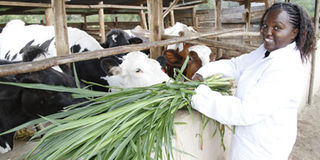It pays to insure your animals

Sarah Wacuka Mwangi feeding some of her dairy cows on March 13, 2014 at her Jonima Farm in Ngong Photo/ JEFF ANGOTE (NAIROBI)
What you need to know:
- It’s this financial setback that drove her to look for a way out. Insurance, she figured out, would come in handy and save her thousands of shillings in case she incurred another loss.
- Sarah has 34 dairy cows, but has renewed insurance cover for eight animals at Sh1,260,000 with a premium of Sh50,627 a month. She plans to insure more cattle.
A few years back, Sarah Wacuka Mwangi lost one of her best cows to East Coast Fever, a tick-borne disease. She tried for three months to save the ailing cow but in vain.
“It was devastating,” she said last week, recalling the pain she went through and the Sh10,000 she spent on treating the animal.
“When the worst happened, I thought there must be a way out. It was clear I needed insurance for the animals.”
Besides the money she spent on treatment, Sarah needed Sh200,000 to replace the dead cow.
LARGE MILK PRODUCERS
It’s this financial setback that drove her to look for a way out. Insurance, she figured out, would come in handy and save her thousands of shillings in case she incurred another loss.
In 2013, she went round in the market and successfully found a suitable insurance company. The insurer recommended she consults a government veterinary to assess the animals, after which her eight cattle were insured, leaving 13 others. “I picked the large milk producers as they were crucial to my business,” she said.
Incidentally, another animal died the same year after swallowing a nail. She immediately informed the insurance company and was paid Sh100,000.
At first she was given a cheque of Sh67,500, but her insurance broker appealed and she was handed another cheque of Sh32,500. She had insured the cow for Sh150,000 and the pay cheque was less deductions.
Insurance firms require the animals to have ear tags for identification. This is because when taking up the cover, one would require a photo of the cow with the tag on. The same is also demanded upon death to ease the claim process. A post-mortem on the animal is also conducted to verify whether the cause is covered and warrants refund.
Sarah has 34 dairy cows, but has renewed insurance cover for eight animals at Sh1,260,000 with a premium of Sh50,627 a month. She plans to insure more cattle.
She gets between 250 litres and 300 litres of milk daily from the 24 cows. The other 10 are not of age. The lowest producer gives her about 24 litres while the best produce 30 litres daily. On average, she earns between Sh15,000 and Sh18,000 a day from milk sales.
Due to high cost of animal feed, Sarah has planted napier grass and hay to limit expenses.
She also makes home-made dairy meal by mixing barley, maize jam, cotton seed and wheat bran. “In the market, a pack of dairy meal goes for Sh1,800 but when I mix my own, I save up to Sh1,000,” she told Seeds of Gold.
Ms Milka Kinyua, the general manager at CIC General Insurance, said that it is important for farmers to cushion their investments against losses. “Livestock is a huge investment and needs to be insured,” she says.
Ms Ashini Patel, the risk consulting manager at KPMG, a financial consultancy, said taking up animal insurance helps mitigate risks.
According to her, it’s a corrective measure. If something goes wrong, then farmers have support and financial back up to fix it.
“By preventing your risk, you make sure that it’s not occurring at any point in time. You have proper controls and systems in place to ensure that losses do not happen. But then, of course, you have to think about that called ‘what if it happens’. That is when insurance comes in,” she explained.
KPMG has an agribusiness department with specialists advising farmers on risk management, growth and expansion.
“We encourage anyone to come and seek advice. We have specialists dealing with risks related to agribusiness and its important this industry grows and we get the best out of it,” Ms Patel said.
Ms Mwangi started farming in 2008 with two cows at her three-quarter farm in Ngong. “It wasn’t a business. But then people started asking if I could sell them milk. This was when I realised there was a business opportunity in it. So I started rearing in bits,” she explained. She also breeds and sells served (fertilised) heifers.




